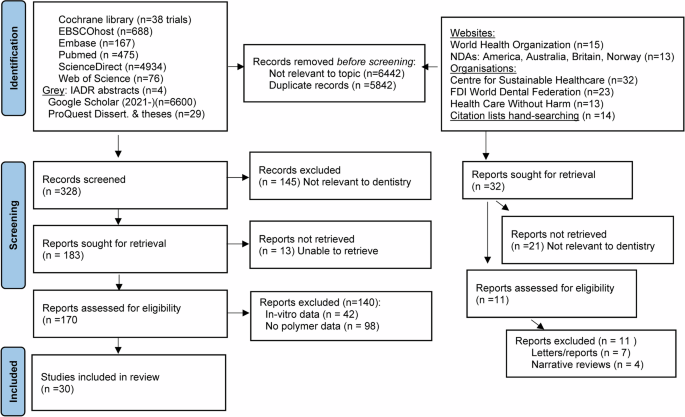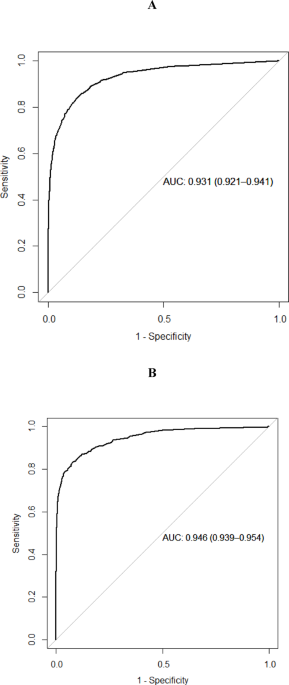Polymer waste and pollution in oral healthcare clinics: a systematic review

Study selection
The bibliometric searches yielded numerous duplicates and records unrelated to the topic. After screening and thoroughly reading the full texts to assess eligibility, we identified 30 references for data extraction (Fig. 1).

PRISMA flowchart detailing the number of records, full-text articles, and studies included at each stage of the systematic review process.
Sixteen papers described waste audits that included data on polymer waste [5, 19,20,21,22,23,24,25,26,27,28,29,30,31,32,33]. Eight studies described polymer NMP pollution in the clinic work area [34,35,36,37,38,39,40,41]. Six experimental laboratory studies reported the potential leakage of monomeric eluates or polymer NMPs from landfill waste [42,43,44,45,46,47].
Polymer waste
Waste generation and management in oral healthcare clinics is a recurring topic in national and international dental and medical journals. However, the number of research papers detailing the qualities and quantities of polymer waste and other waste remains limited. Few waste audits have documented specific amounts and these originate from Iran (n = 6) [21,22,23, 25, 27, 29], Greece (n = 3) [20, 26, 28], United Kingdom (n = 2) [5, 24], the USA (n = 2) [31, 32], and single studies from Australia [33], and Turkey [19]. Relevant supplementary data is a waste audit conducted in a hospital in Australia that identified the most common wasted polymers in surgical operating theatres [30] (Table 1).
Study characteristics
Waste audits conducted between 2002 and 2023 demonstrate various approaches and contexts in which polymer waste is evaluated. Clinical settings include dental faculty clinics (n = 2) [19, 33], dental faculty undergraduate preclinic (n = 1) [32], private clinics (n = 5) [20, 22, 26, 28, 31], public clinics (n = 2) [25, 27], mixed clinics (n = 2) [5, 24], speciality clinics (n = 2) [21, 23, 29], and one surgical operating theatre [30]. Sample sizes differ markedly, with the most significant number of treated patients totalling n = 2542 over 20 days [26, 28]. Some focus on the number of clinics involved. While most publications mention the number of clinics, many fail to specify the number of operatories within each clinic. Only five publications report the number of patients treated during the sampling period [5, 26, 27, 29, 33]. The duration of these studies also differs, ranging from a single-day audit [33], to multi-month observations [29]. The primary data collected from all studies are the masses of polymer waste, although additional details, such as waste per compound, were scarce [30]. Notably, the study by Martin et al. documented 150 observations by auditors over 120 days across three different types of clinics: a teaching hospital, an NHS primary care clinic, and two private primary clinics [5] (Table 2).
Risk of bias
Waste audits are conducted for various reasons, and ethical approval is not always required. Some identified reports cited national regulations, while others underscored the necessity for logistical planning within local communities. Several waste audit studies explored best practices, which may require ethical approvals in certain countries. Most reports did not disclose their funding sources; however, some indicated that they received funding from universities and the public. The scores from the eight questions, which assess the potential risk of bias, ranged from 2/8, signifying a high risk, to 5/8. Concerns regarding potential bias were because of i) a failure to segregate monomaterial waste from layered material waste, ii) a lack of segregation between non-polymerised material and polymerised polymeric materials, and iii) the inability to distinguish the quantities of different hard and soft polymers, including HDPE, LDPE, PET, PP, PS, PVC, SR, and elastomers. Two studies were evaluated against fewer criteria because of their particular study objectives [5, 32] (Table 3).
Results of individual studies
Numerous studies failed to provide estimates of the mean mass of polymer waste per patient, procedure, day, and year. These estimates had to be derived from other data presented within the papers. The polymer waste per patient information is sourced from six studies [5, 26, 28, 29, 32, 33]. Estimates of the waste attributed to specific items per patient are ~81 g of aprons [33], 4 to 56 g of gloves [26, 28, 29, 32, 33], 13 to 24 g of impression materials [32, 33], 3 to 17 g of masks [32, 33], and 3 g of suction tips [29]. A substantially higher estimate of polymer waste per patient is 384 g, due to discarded single-use items [5]. Nine studies provided data to enable estimates of polymer waste per operatory room per day [5, 19, 20, 24, 26, 28,29,30, 33]. The amount of waste in hospital operating theatres is not directly transferable to oral healthcare clinics [30], but PET predominates, which has also been identified as the primary aerosol contaminant in oral healthcare clinics [41].
The estimated total annual mass of SUP waste from 47,000 oral healthcare professionals in the United Kingdom who perform operative procedures on five patients per day for 160 days per year is 14.4 tonnes [5]. If additional COVID-19 protection is required for the clinic staff, the estimate becomes 27 tonnes [5]. With these premises, a single professional generates 307.2 kg of SUP waste per year, 1.92 kg per day, and 384 g per patient. If additional COVID-19 protection for the working staff is required, the estimates are 575.2 kg per year, 3.6 kg per day and 719 g per patient. The estimates surpass those based on waste audits conducted in Iran [21,22,23, 25, 27] and the USA [30].
Considering the various study designs, potential biases, and evaluated outcomes, we found it unfeasible to combine the data in a meta-analysis (Table 4).
Polymer pollution into air and waterways
On-site sampling studies of polymer pollution in oral healthcare clinics have concentrated on the emissions of polymer NMP into the ambient air during actual clinical interventions [34,35,36, 38,39,40,41]. One study conducted in a hospital clinic contributes to the existing data by describing aerosolised polymer pollution produced in a cardiothoracic surgical operating theatre [37] (Table 5).
Study characteristics
The study clinics varied markedly and included one open-concept clinic comprising six units [39], one public clinic [38], one hospital operating theatre with an adjoining anaesthetic room [37], and six clinics (three private and three public) featuring between one and seven operatories [34]. The participants and sample sizes ranged from n = 10 [39], to n = 84 adult patients undergoing 253 procedures [38]. Additionally, the interventions varied, with the dental interventions comprising routine adult dental care [34, 38], or orthodontic bonding and debonding [39]. The analytic technologies included optical particle sizers, mass concentration measurements using laser photometers, personal samplers for microbial analysis, glass sampling beakers analysed via micro-Fourier-transform infra-red spectroscopy, and thermal desorption tubes examined with gas chromatographs. Ultimately, the results comprised particle count (n/m³) or particle mass concentrations (ng/m³), the distribution of chemical compounds, and monomer concentration above the patient’s mouth and in the clinician’s breathing zone (Table 6).
Risk of bias
The potential risk of bias was considered low for two studies [34, 37]. The other two papers lacked detailed information regarding the calibration process for the analytical equipment and were therefore considered to have a low to moderate risk of bias [38, 39] (Table 7).
Results of individual studies
Working with polymer materials in patients’ mouths releases NMPs containing 2-HEMA and TEGDMA, with the highest concentrations found just above the patients’ mouths. Still, these rapidly dilute further from the working area [34]. Hospital surgeons are exposed to atmospheric NMPs, with the predominant compounds being volatilised PET, PP, PE, and nylon [37]. The quantity and dimensions of NMPs in dental clinics are influenced by the type of rotating burs and other work instruments clinicians use [38]. Ultimately, the quantity of NMPs increases during work procedures but may surge even higher after the procedures are completed [39] (Table 8).
Any meta-analysis was deemed unsuitable due to the heterogeneity of study designs and outcomes measured.
Waste landfill disposal and monomeric eluates or polymer NMPs
The potential pollution from waste containing polymers deposited in municipal landfills has been explored only by a limited number of studies by a research group in Sheffield, U.K. [42,43,44,45,46,47] (Table 9).
Study characteristics
The characteristics of the various simulation studies conducted by one research group at the University of Sheffield, U.K., were relatively consistent. A common feature is that polymer specimens or NMPs produced from these specimens were stored in solutions mimicking municipal landfill conditions, including incubation in sterilised and non-sterilised landfill leachate [43, 44], ‘microcosms’ storage for three months [45], and groundwater at 10 °C for 12 months [46], or in tap water for 12 months [47]. Various analytical methods, including chromatography, spectrometry, potentiometry, and electron microscopy, were utilised to identify particle compounds, dimensions, and protonation-deprotonation behaviours across multiple pH levels and time points (Table 10).
Risk of bias
The data from the simulation studies were presented at IADR research meetings [42, 43, 45, 46], and in proceedings from one conference [44]. The possibility of thoroughly assessing all methodological aspects of the experiments is limited; thus, their risk of bias is high when considered individually. However, the results are either summarised or referenced in a single peer-reviewed publication, which has been deemed to have a low risk of bias [47] (Table 11).
Results of individual studies
The experiments carried out by the research group over a decade yield incremental findings. The initial study, conducted in 2015, outlines the leakage of predominantly Urethane Dimethacrylate (UDMA) and Triethylene Glycol Dimethacrylate (TEGDMA) monomeric compounds from resin-based composite (RBC) waste [42]. The subsequent reports describe how aged NMPs exhibit markedly different surface characteristics compared with fresh NMP, as well as compelling data indicating the role of microorganisms in the degradation process and the release of eluates [43,44,45,46]. The latest experiments provided further evidence of the likelihood that the behaviour of protonation and deprotonation across the pH range creates surface groups capable of binding at sites involving carboxyl (pK≈3–5), silanol/silica (pK≈6–7), and hydroxyl groups (pK>8) [45, 47] (Table 12).
link







